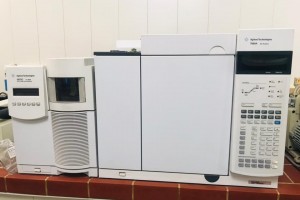
The thesis presented by the researcher (Renin Salem Sawadi) included
Corrosion is one of the most prominent problems that many establishments and sectors suffer from, which results in huge economic costs represented by a decrease in efficiency and performance, and thus a decrease in production and other losses, which are difficult to determine in homes, means of transportation, bridges, buildings, means of energy production and oil facilities. and gas. In view of the importance of the above subject, (10) heterocyclic compounds were prepared in this study, as follows:
DTB= (1,4-di(1,3,5-dithiazinan-5-yl)benzene)
DTB-C10= (5,5'-(1,4-phenylene)bis(5-decyl-1,3,5-dithiazinan-5-ium)bromide)
DTB-C14= (5,5'-(1,4-phenylene)bis(5-tetradecyl-1,3,5-dithiazinan-5-ium)bromide)
TB= (5-phenyl-1,3,5-dithiazinane)
TB-C10= (5-decyl-5-phenyl-1,3,5-dithiazinan-5-ium bromide)
TB-C14= ( 5-phenyl-5-tetradecyl-1,3,5-dithiazinan-5-ium bromide)
DM-C10= (N1,N4-didecylbenzene-1,4-diaminium bromide)
DM-C14= (N1,N4-ditetradecylbenzene-1,4-diaminium bromide)
AN-C10 = (N-decylbenzenaminium bromide)
AN-C14= (N-tetradecylbenzenaminium bromide)
The prepared compounds were identified using analytical and spectroscopic techniques such as mass spectrometry, infrared spectroscopy, and proton nuclear magnetic resonance spectroscopy. The study also included the use of the prepared compounds as surface activators and corrosion inhibitors for carbon steel alloy type (C 95) in an acidic medium (2 M) from an aqueous solution of HCl acid. And at two temperatures (298, 323 K) in the absence and presence of the inhibitors and at concentrations (1×10-4, 5×10-4, 1×10-3, 5×10-3 molar) and using the extrapolation polarization method as shown. The results showed that the values of corrosion current density (Icorr) for carbon steel in the presence of inhibitors were less than their values in the absence of inhibitors, and that the addition of inhibitors and a range of concentrations under study to the acidic solution reduces the corrosion current density for each temperature, and in general the corrosion current density increases with increasing temperature for single focus. As for the inhibition efficiency, it was shown that it increases with the increase in the concentration of the inhibitor for each temperature separately. In general, it was noted that the inhibition efficiency of all inhibitors decreases with the increase in temperature for one concentration of the inhibitory substance. The percentage values of the experimental inhibition efficiency for compounds (DTB-C14, DTB- C10, DTB) amounted to (92.9, 91.0, 90.3%), respectively, which is higher when compared to the inhibition efficiency value of the prepared compounds. The results of the Tafel curves method showed that the prepared compounds are of the type of dual inhibitors.
The study also included knowing the efficiency of the prepared compounds as corrosion inhibitors for carbon steel in an acidic medium (2M) of an aqueous solution of HCl at a surface temperature of (25, 50°C) using the weight loss method. The results showed inhibition efficiency values close to the values obtained by the Tafel curves method for the compounds under study, and also these results were compared using a commercial inhibitor (HAI-OS) that gave inhibition efficiency (99.1, 98.7%) at the same temperatures, which are Acceptable value of inhibition efficiency in the oil industry.
Also, tests were conducted for the compounds prepared as inhibitors for corrosion of carbon steel in an acidic medium (2M) of an aqueous solution of HCl acid in a reservoir for the Mishref and Zubair layers at temperatures (79.4°C, 100°C). Concentration. Based on these results, it was found that the values of inhibition efficiency that appeared at Mushrif and Al-Zubayr layer for the highest concentration of inhibitors have the same order of inhibition efficiency for the compounds prepared in the laboratory at temperatures (25, 50 °C) using the complementary polarization method.
In addition, the biological activity of some compounds prepared in this study was studied for two genera of pathogenic bacteria, one of which is Gram-positive (Staphylococcus aureus) and the other is Gram-negative (Escherichia coli). The drilling method was adopted by corkscrews and the inhibition diameters were measured in millimeter units by means of a ruler. The results showed the biological effect of the solutions of the compounds prepared from them at a ppm concentration (1000) that act as inhibitors of bacterial growth, as each of the compounds (DTB, DTB-C14, AN-C14, DM- C14) High inhibitory ability.








